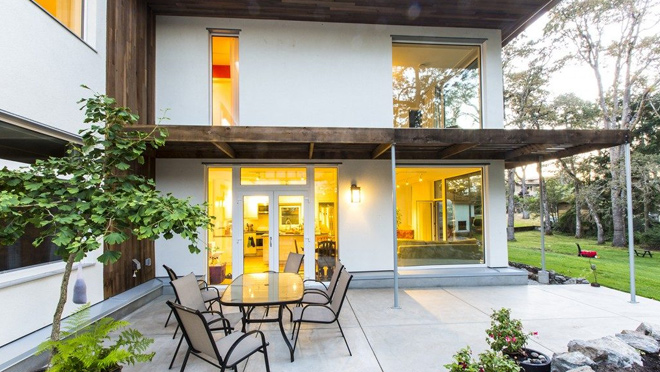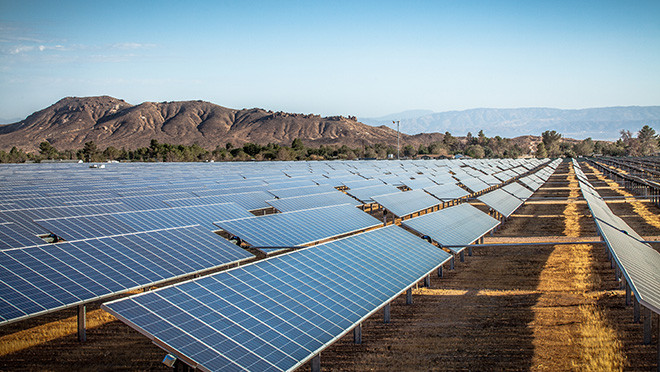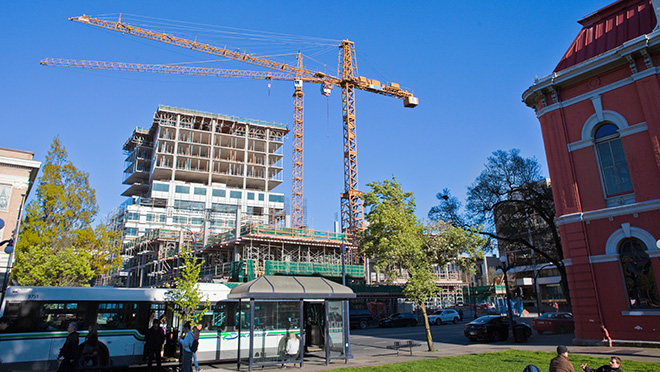September 2024
In this edition:
- Partner Q & A: Mark Bernhardt, home builder and CHBA BC president
- Electricity stays clean in B.C., even with imports
- Local governments page makes it easier to find info
- Dig once: Island workshops focus on coordinated planning
- Incentives change the math on solar power, energy storage
- News about BC Hydro and from around our community

Partner Q & A: Mark Bernhardt, home builder and CHBA BC president
Please note that this Q & A has been updated from the original published in September 2024.
As a home builder with deep expertise in how to produce better, more sustainable housing in B.C., Mark Bernhardt recently stepped into the president role of the Canadian Home Builders Association B.C. (CHBA BC), which has more than 2,300 industry members. President and owner of Victoria’s Bernhardt Contracting, the Vernon, B.C. native started working in construction while earning a degree in Earth Sciences from the University of Calgary. He also worked on oil and gas pipeline environmental assessments before graduating and heading back to B.C., where he's become an advocate for high performance construction, in part after building and moving into a certified passive house of his own in Victoria in 2013.
We chatted recently with Bernhardt about building to new codes, the role of CHBA BC, and how governments and BC Hydro can support housing developments in the province.
Plugged In: How did you decide to make better home construction your career?
Mark Bernhardt: In my first career [in environmental assessments] I worked on some notable projects around the country, counting caribou, endangered goats and skunks and things like that. That was fun in my early 20s, but as it became less fun, I moved back to B.C. to be closer to family and figured that, as a project manager, I could work in construction. I began to realize that you can apply the same sort of impact assessment methodology you would do for an oil project to a house or renovation. I started to use my science background to play around a bit with construction and decided that I needed to build my own house.
PI: You wound up building and living in a passive house in Victoria. What did you learn from that?
MB: The house I'm sitting in right now is that house, and the most fun thing about it is that it actually worked. It was an experiment, a big risk at the time. People told me it was a dumb idea, or that it would be too expensive. We had to prove the business case, and we proved it wasn’t expensive. From that, we started our first development company. I think one of the keys to success with this project is that we understood that we didn’t know a lot of things, and we asked for help. We got all the key players in the room to give their expertise. We didn’t know it at the time but what we were doing was integrated design, and we’ve used this strategy on all of our projects since.
PI: What do people need to know about the CHBA and its role here in B.C.?
MB: We’re the voice of the residential building industry, specifically builders of small buildings, from single-family homes to that missing middle housing of six-plexes or smaller. We advocate for the industry and for our clients around everything from consumer protection to the ability of our members to conduct a business that’s relatively easy to run and that can feed our families. This part of the industry represents billions of dollars in B.C.’s economy and thousands of jobs. On average it takes the work of 200 people to complete a home.
PI: What’s your role as president of the CHBA’s B.C. chapter?
MB: First of all, I have to say that it’s been a lot of fun travelling around B.C., talking to a lot of people, hearing their gripes and celebrating their successes. I think the reason builders elected me to this position is specifically because of my skillset in high performance building. We're looking at a fairly significant change in how we look at our codes and how we build our buildings. And that’s scary for a lot of people. They need somebody to sort of hold the lantern and guide them through the dark. And as it turns out, it's not that dark.
PI: Let’s dive into the stuff that scares some builders. As an experienced high-performance builder, what’s your take on updates to the BC Building Code that address energy efficiency and zero carbon fuels in new construction?
MB: I think the main thing builders often forget is that these codes are, in many ways, designed by builders for builders. For the BC Energy Step Code, for example, the government came to the building industry with a problem that is climate change, and said: ‘How are we going to fix this?’ And industry said ‘Let’s do a phased approach that’s predictable, and let's do it step by step. The result is the BC Energy Step Code and Zero Carbon Step Code.
PI: In your experience, what is it like to work with these building codes?
MB: Codes traditionally have been prescriptive. That doesn't allow for any innovation or creative thinking or optimization. The new Step Codes are performance-based and that allows us to innovate. For example, when building a wall, the old code said you must use three nails in each 2x4. Now the code says that wall must stand up and be strong. There are hundreds of ways I can make that wall that allows for innovation. What we're seeing now is that we, and many of our clients, are reducing the cost of building in ways we never really thought possible, and weren’t possible, with a prescriptive-based code. This doesn’t mean houses are getting any cheaper. There are still many rising costs, but they aren’t rising as fast as they would have otherwise.
PI: Can it really be less expensive to build to these codes? One of the things we hear from builders is the expectation of additional costs of building to the new standards.
MB: Our observations, and our own experience, is that it can actually cost quite a bit less when you optimize. We do that by taking careful care in our design phase in particular, so that we're designing for the performance codes, not designing against them. Those who innovate can do that and lower costs.
PI: There’s also a perception out there that the Zero Carbon Step Code is going to drive up electrical panel sizes and, with it, drive up connection costs. Is that something that’s happening?
MB: We haven't seen that, but I’ve certainly heard those rumours. Cooling is now a standard requirement in new construction and that is the factor that is driving panel size. Once you have cooling in the design, if you choose a heat pump, then you get the heating for free on your panel. People suggest that allowing gas heating will reduce costs linked to panel size upgrades, but this just isn’t the case around Vancouver and on Vancouver Island where the vast majority of B.C. residents live. Heat pumps don’t need supplemental backup in these areas. As we go further north in B.C., we may see the need for supplementary heat where temperatures get so low that a cold climate heat pump wouldn’t be able to handle the demand for heat. In those locales, hybrid or baseboard systems may be needed, which could increase panel size. The main reason we see panel size increases in the Lower Mainland and Vancouver Island is for luxury loads such as hot tubs, pools, and driveway heaters. But to be clear these are systems that are not governed by the Zero Carbon Step Code. In all my projects, we are installing heating, EV charging, and regular plug loads on a standard 200-amp panel. We also have cases where we are seeing a reduction in panel size as a result of dropping some of the gas appliances, since they also require electricity.
PI: We’re expecting to see many more multi-family and small multiplexes in the coming years. How, in your experience, do equipment and cost implications change for these buildings?
MB: From a cost perspective, I would expect to see affordable, missing middle housing to be all-electric. Space constraints are real, so big centralized furnaces aren’t common. Instead we are seeing small, individual unit heating and cooling systems – typically baseboard with mini-split heat-pumps that do both heating and cooling. None of the missing middle homes we are working on heat with gas, and very few use it for hot water – it’s just too expensive.
PI: You’ve been building towards the highest steps of both step codes for a while. What would you tell a builder who doesn’t have experience in building with the Zero Carbon Step Code in mind, and who is now concerned about cost increases?
MB: We encourage builders to join our CHBA Education Series called Simplifying Complex Carbs, which helps break down common practices to achieve the highest steps of both Codes, and clearly shows how it can be cost-effective and achievable. This session will also bring both Fortis and BC Hydro in to answer the hard questions about the energy transition and what role electricity and other low carbon fuels can play. Also we recommend finding an energy advisor to go to bat for you and help you along the way, as well as supporting your team in an integrated design approach. That’s really the key. Hopefully, you can get a really solid design from the start so that your trades aren’t nervous about it. If trades come don't really know what's going on because it's something new or different, that's where the costs and mistakes come from.
PI: How can local governments improve their communication with the building industry when it comes to code adoption?
MB: Be clear, be firm, and be predictable. We just saw the City of Vancouver being very unpredictable [in reversing its earlier ban on gas heating in new homes]. I know there are some in our association who may cheer that reversal, but the reality is most of our builders have already set up to accommodate the original rule. So being unpredictable like that isn’t helpful. It also won’t help with affordability because gas is the more expensive option – even if their projects have the budget, I don’t see many builders switching because they have already changed their systems. Industry needs clear direction and advance notice, so that we’re able to all march to the same drum.

Electricity stays clean in B.C., even with imports in the mix
Our mainly hydroelectric power generation has long provided a great advantage, both in meeting the demands of B.C. homes and businesses, and in trading power with our neighbours.
By storing water behind our dams, our generation stations act like giant batteries. The power is there when we need it, and when we have energy to spare, we can send it to our neighbours to the east and south.
A remarkable 98% of the electricity we generate is from renewable resources, with more than 90% from hydroelectric power stations. The carbon intensity of the electricity used in B.C. is among the lowest on the continent.
How low? Greenhouse gas intensity of the electricity used by B.C. customers on what we call the integrated grid (which includes imported power) is determined by the Government of B.C.'s Climate Action Secretariat. Our integrated grid’s carbon intensity of 11.3 tonnes of CO2 equivalent per gigawatt-hour in 2023 compares to about 430 tonnes of CO2 for natural gas-powered electricity generation and more than 1,000 tonnes of CO2 for petroleum and coal-fired generation.
The average carbon intensity of electricity generation in Canada (170 tonnes per GWh) is 15 times that of B.C.'s integrated grid. The U.S. carbon intensity average is 32 times B.C.'s, at 369 tonnes.
How electricity trading works for BC Hydro
Our power-trading subsidiary Powerex is constantly trading with other utilities through the Western Electrical Grid to take advantage of hourly fluctuations in electricity prices and keep our B.C. rates low.
Powerex employs what it calls a Clean Energy Trade Standard to ensure that 100% of B.C.'s customer load is met through clean electricity. The bulk of imported generation in 2023 was from Washington State (mainly hydroelectric) and California (wind and solar), and included some wind-generated power from Alberta.
We must generate enough power to be self-sufficient on an average water year, but over the course of years when there's significant drought in B.C., we may be a net importer. We're building out our supply through the Site C hydroelectric project and the new Call for Power (renewable generation through independent power producers) to ensure we continue to be self-sufficient going forward.
A lot of our 2023 imports happened in the summer when, despite generally lower energy demands in B.C., imported power purchased at lower rates allowed us to store water behind our dams to provide energy for our peak loads in winter.
This past January 12, a record big freeze hit B.C. and Western Canada, and we set an hourly B.C. peak electricity demand record of 11,300 megawatts (MW). But we had enough water stored behind dams that we met that record demand and had enough power left over to send 200 MW of electricity to Alberta.
"Having these reservoirs gives us kind of a unique capability," says Bill Clendinning, BC Hydro's director of energy planning. "We take some pride in seeing our plans pressure-tested like they were this past winter. But I don't think we're resting on our laurels. As planners, we're still vigilant as we try to make sure we’re getting it right and properly serving the needs of British Columbians."

Local governments page makes it easier to find key info
There's a whole lot of helpful information for local governments on our website, and it just got easier to find.
The new local government information and support page will act as a time saver for local government staff looking for info on a range of information, from electrical connections to electric vehicles, to rights of way guidelines and community regreening programs.
"At BC Hydro, we have several different groups that interact closely with local governments," says BC Hydro's Meredith Toward, who consulted various groups inside and outside BC Hydro for feedback on what should be included. "This page brings it all together, as a wayfinding resource for everyone from elected officials to local government staff and beyond."
The page will act as a companion resource to our Sustainable Communities section, which remains the go-to resource for specifics around funding programs for community energy managers, students, and community energy projects.
Included on the local government page are links to frequently asked questions and to dozens of resources grouped under the following:
- Planning for our future: Information about our system-wide strategy for meeting electricity demand.
- Expanding our infrastructure: Quick links to projects including the Site C energy project.
- Adapting for B.C.'s changing climate: Outages and safety info, evacuations, and climate adaptation.
- Electrical connections: Processes for initiating, installing, or modifying customer connections.
- Electric vehicle support and infrastructure: EV charging infrastructure, rebates, fleet funding and EV charging host resources.
- Community services, funding, and guidelines: Guidelines and programs for new builds and improvement projects in your community.
- Rebates, incentives, and support for energy-efficient and electrified communities.
Not sure you'll remember how to find the page that gets you to all that information? Bookmark the page or remember the friendlier link bchydro.com/localgov.
Looking for something that you'd expect on the new page but can't find? Email us with your ideas.

Dig once: Vancouver Island workshops focus on coordinated planning
As we lean on clean electricity to reduce the use of fossil fuels in buildings, transportation and industry, customer demand for electricity is expected to grow by 15% by 2030. There's a lot of BC Hydro infrastructure work ahead, to the tune of $36 billion over the next decade.
In tight, urbanized areas this work requires close collaboration with municipal planners and engineers. It's not easy to build upgrades into busy streetscapes and communities with minimal disruption.
Digging once benefits everyone. And aligning local government and BC Hydro permitting and approvals processes is key to reducing builder costs to help the development industry to construct housing needed for our growing population.
In June we held two workshops in southern Vancouver Island to explore these issues. Here's a quick overview of what happened.
Big projects, better planning on southern Vancouver Island
In previous years, each municipality or utility would share their plans for a project with little opportunity to shift a project's timing or to align with other stakeholders. This has often led to streets facing disruption multiple times at the same location.
At a June 10 capital project workshop, 13 southern Vancouver Island municipalities discussed large capital projects in efforts to find opportunities to co-tender or sequence activities to minimize traffic and community impacts, such as digging up a road multiple times in the same place.
A hit at the workshop was a presentation on mapping tools that display the location of large capital projects planned by both municipalities and utilities such as BC Hydro, FortisBC, and Telus.
"The map was very well received and helped to identify areas where we could work together with municipal partners," said Bob Falloon, a BC Hydro program and contract management manager.
Falloon cited three potential areas for improvement:
- Co-tendering
- Improving scheduling by using the same contractor
- Reducing public impact by shortening the time roads are impacted by construction.
Coordinating development and permitting
A second workshop, held on June 14 with the City of Victoria and District of Saanich, focused on streamlining the developer and customer connection process in the region.
The municipalities of Victoria and Saanich, as well as BC Hydro, currently interact with builders and developers at different stages of the development and building permit process. There are opportunities to improve processes to accelerate customer connections by avoiding re-work, delays, and back-and-forth reviews between departments.
"We hope to be able to apply these learnings and host these types of sessions with other municipalities and utilities in the future," said Jacqueline Spray, our director of customer engagement and sales. "The goal is to improve coordination and cost savings."

Incentives change the math on solar power, battery storage
Our incentives for industrial, commercial, and residential solar projects will make it easier to make a case for investment in solar and expand customer buy-in beyond early adopters. The incentives come just months after the federal government stopped taking applications for the Greener Homes Program, including grants of up to $5,000 for solar generation projects.
"We've had tons of interest from industry and lots of questions from customers – all sorts of stakeholders interested in the new offers," says BC Hydro program manager Margo Longland.
Since the program launched on July 23, rebates became available for up to $5,000 on eligible grid-connected solar panels and up to an additional $5,000 for battery storage systems to qualifying residential customers. Eligible businesses and multi-unit residential buildings can access up to $50,000 in combined solar and battery incentives, while combined rebates of up to $150,000 are available for social housing, Indigenous communities, and remote micro-grid communities.
For large commercial and industrial customers, we offer feasibility study funding, and custom incentives (for solar, wind, micro hydro, waste heat recovery, and other self-generation based projects) for load displacement.
The basic eligibility requirement for all solar and battery storage rebates is that projects be connected to the BC Hydro grid through our self-generation program (previously called net metering).
Incentives are limited to new projects and/or the expansion of current self-generation projects.
News about BC Hydro and from around our community
- The City of Victoria recently published two reports – including case study examples of real projects for Part 3 and Part 9 buildings – to highlight buildings that are meeting B.C.’s Zero Carbon Step Code (ZCSC) for space and water heating.
- New BC Hydro infrastructure projects are powering growth in several B.C. communities, including the North Shore and Sea to Sky Corridor, the southern interior, and in Surrey.
- New and retrofitted buildings at BCIT are all part of a living lab
- Surrey is happy to host EV charging hubs